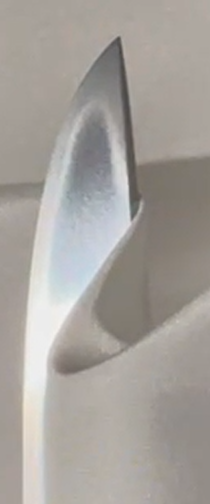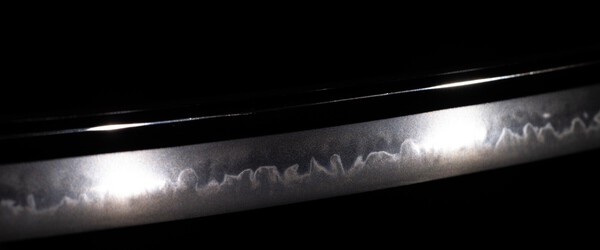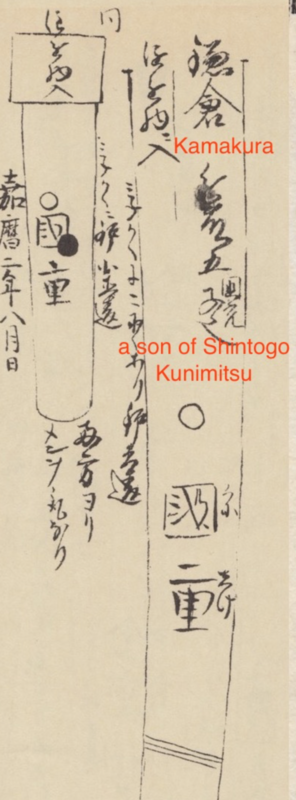-
Posts
1,513 -
Joined
-
Last visited
-
Days Won
5
Content Type
Profiles
Forums
Events
Store
Downloads
Gallery
Everything posted by Lewis B
-

Dai Token Ichi this weekend!
Lewis B replied to MassiveMoonHeh's topic in General Nihonto Related Discussion
How much is Eirakudo asking and how prominent is the midare utsuri? -
@Lexvdjagt kindly sent me a short video and photo of the nakago of an exceptional Shintogo Kunimitsu tanto currently on display at the Japanese Sword Museum in Tokyo. This one was posthumously bequeathed to the museum from the Suzuki collection. The tanto itself is probably one of the best examples I've seen. The deki is archetypical Shintogo, ubu with a nengo for 1316. The nagasa is 21.9cm with a slender sugata. There are beautiful lines of kinsuji, one of the key features of this smiths work. Overall it appears to be a very healthy, original example. If the NBTHK published something about this blade it would be interesting to see. Setsumei, kantei etc?
-

Dai Token Ichi this weekend!
Lewis B replied to MassiveMoonHeh's topic in General Nihonto Related Discussion
I was hoping to attend but the German Gov have been dragging their feet processing my Settled Status application, which meant I couldn't travel outside Germany. Oh well 2026 then..... Everyone have fun and if you happen see that "Shintogo" tanto (#55) on the Ginza Japanese Sword Museum Taibundo stand, please let us know what you think. Do the papers attribute the blade specifically to Shintogo or are they less specific. The dealer has ignored efforts to get more info via email. -
Here is a tachi blade worthy of consideration if you're interested in Ko-mihara. Ubu, zaimei, nengo (1384), quality koshirae and fittings. Juyo papers. Approx 80cm nagasa https://www.toukentakarado.com/item-tk019-juyo-token-mihara
-

catching out Jauce on there bullshit
Lewis B replied to lonely panet's topic in Auctions and Online Sales or Sellers
Could be a case of a 3rd party hijacking the real sellers listing and making a profit on the actual sales price. 3rd party buys for 17,300 and sells for 35,300 JPY. Seems like a lot of work for little reward. Happens a lot on Ebay where items the seller doesn't have get posted for 30%+ more than the item can be bought for on Jauce/Yahoo.jp auction site. -
Well, it depends. He won't say in writing but the person who collects it after getting the sayagaki could ask for his opinion and, assuming he has a friendly relationship with the dealer, you should have a good idea where it stands. The sayagaki could also give you an indicator. If he writes it's a masterpiece amongst the work of the smith it's a good start. But obviously its not a sure thing. Recent Juyo Shinsa have been 'strange' to say the least.
-
That great news. Make sure the dealer asks Tanobe sensei if it has a chance at Juyo and you can make an educated decision if it's worth being without the sword for a prolonged period. With the current shipping uncertainty and that the blade is currently in Japan I'd be more inclined to submit to Shinsa if Tanobe responds positively.
-
I assume someone in Japan would act as an agent for submission, retrieval and subsequent relocation. Since Sky is buying from a big name dealer in Tokyo I would hope they would agree to provide that service (perhaps for a fee).
-

Help With Approximate Age and Sugata of Blade with Partial Signature KUNI
Lewis B replied to tbonesullivan's topic in Nihonto
It has katana mei so that would put it early Muromachi at the earliest. Could be an earlier blade but later signature. -
So says the "informed amateur"
-

Looking for thoughts on this Rai Kunitsugu marked blade.
Lewis B replied to Brian Dent's topic in Nihonto
Chicago isn't too far for you. Take it to the next show to be checked out by knowledgeable eyes. -
Juyo shinsa happens once a year in October. If it fails it'll likely be released towards end of the year. If it passes you have to wait for the papers and oshigata to be completed. You won't see it again until early 2027. Obviously worth the wait in the latter instant
-
The Kiyomitsu will be a worthy addition to the collection. Are you planning to submit it for Juyo? Might be worth letting someone like Tanobe take a look and give his thoughts. I can see the ugly umegane on the Nakajima Rai blade. It has a powerful sugata and old NBTHK Juyo papers. Shame.
-
I'm guessing its this one. Nice choice and looks very healthy. What was it about this blade that tipped it for you vs the other 2. A Tanobe sensei sayagaki would be the cherry on the top. https://world-seiyudo.com/product/ka-060123/
-
Artistry is subjective and in the eye of the beholder.
-
Very attractive workmanship and subject. I also think this represents an indigo dyeing scene under moonlight with the final bolt of fabric on a roller.
-
Not true. I've seen this sword in hand and I can say emphatically, this photo is a good representation of the quality of workmanship the blade exudes. What is true is that photos are only as good as the photographer and his equipment, as this example demonstrates. The midare utsuri is just as vivid in hand as it is in the image, as is the nioiguchi in the hamon.
-
Is this for sale. If yes, you forgot the price. Might be a good idea to post measurements and some closeup photos as well as one without the tsuka (handle). Does it have modern NBTHK or NTHK papers?
-
The Mei is for Nagayoshi.
-
Looking forward to hearing more about the blade and the smith.
-
These are invaluable resources and being ebooks means the reader can use the very practical search feature. It was primarily access to these reference volumes that I was able to purchase my last sword. Books like the eSwordsmiths volume should be on every nihonto collectors computer. Thanks for making this generous offer available again.
-
Maybe Mr Brannow can hook you up. https://www.artswords.com/2003_dai_token_ichi_catalog_091513.htm
-
If you're correct about masame in the DTI blade Nicholas, it could be by Hasebe Kunishige (Markus indicates a connection with Shintaro Kunimitsu, same smith?). The data is inconclusive although the masame points to Yamato influence. The 'wet' appearance of the steel also fits. KUNISHIGE (国重), 1st gen., Kenmu (建武, 1334-1338), Yamashiro – “Hasebe Kunishige” (長谷部国重), real name Hasebe Chōbei (長谷部長兵衛), it is said that he came originally from Yamato province where his ancestors lived in Nara´s Hatsuse (初瀬), there exists the tradition that the family name Hasebe was, over “Hase,” a modification of the pronunciation of “Hatsuse,” another theory says that he was the son of Senju´in Shigenobu (千手院重信), so it is assumed that his roots were in the Senju´in or in the Taima school, some sources state that he moved to Kamakura to study as late student under Shintōgo Kunimitsu (新藤五国光) before he finally settled in Kyōto/Yamashiro, this is supported by the tradition that Kunimitsu too bore the family name Hasebe, some even assume that Kunishige was the son of Shintōgo Kunimitsu, however, he moved around Kenmu to Inokuma (猪熊) in the Bōmon district (坊門) in the vicinity of Kyōto´s Gojō axis (五条), he is listed as one of the “Ten Students of Masamune,” unfortunately no signed works are extant by the 1st generation Hasebe Kunishige, his most famous work is the meibutsu Heshikiri-Hasebe (圧し切り長谷部) which was once the favourite sword of Oda Nobunaga, this and other ō-suriage-mumei blades have a wide mihaba, a thin kasane, a shallow sori, and an elongated kissaki, the mune is iori or maru, the jigane is a dense ko-itame which tends to masame towards the ha and the mune, the hamon is a notare mixed with gunome with plenty of hataraki within the ha like ashi, yō, sunagashi and kinsuji, towards the upper blade section also tobiyaki appear which can turn into a hitatsura, the bōshi is midare-komi with hakikake and a somewhat pointed kaeri, unsigned blades of the 1st and 2nd gen. are hard to differentiate, the jigane of the 1st gen. looks more “wet” and “sticky” whereas the ha is more bright, jōjō-saku ⦿
-
I don't think thats correct. This is the date inscription which I interpret as a year in Showa (Showa 2? [1314]). Such a late date certainly raises some concerns. As Nicholas says this 'Kunimitsu' is going to be an interesting study piece. If I was a betting man my money would be on daimei daisaku by Shintogo's oldest son, Shintaro Kunishige (tanto on left dated Karyaku 2 [1328]). At least a couple of historical references state both he and Kunihiro signed Kunimitsu. KUNISHIGE (国重), Karyaku (嘉暦, 1326-1329), Sagami – “Kunishige” (国重), “Hasebe Kunishige” (長谷部国重), “Sagami no Kuni Kamakura-jūnin Hasebe Kunishige” (相模国鎌倉住人長谷部国重), son of Shintōgo Kunimitsu (新藤五国光), he signed in early years also with Kunimitsu (国光), first name Shintarō (新太郎), it is unclear if he was the same smith as Yamashiro Hasebe Kunishige The Jubi #198 is interesting. Nakago shape is quite similar to the DTI Kunimitsu












